Insight: Bringing Porsche’s Most Elusive Le Mans Project Back to Life
Sportscar365 explores how Porsche revived its canceled Le Mans Prototype after 25 years of hibernation…
It’s a pleasant Thursday afternoon in Weissach. As always, the town that hosts Porsche’s research facility is a hub of activity, but it seems like any other day. Until, just after lunchtime, that impression is shattered by a sound that most people in the area wouldn’t have heard for more than two decades.
An engine, confidently roaring into life, breaks the silence. Down at Porsche’s legendary test track, mechanics give each other looks of approval. Everything appears to be going to plan.
The engine they just started is a 5.5-liter, naturally aspirated V10. And it lies in the back of one of the most elusive cars Porsche has ever built. The LMP 2000 - the car that never raced.
And on this day in Weissach, Porsche Motorsport invited Sportscar365 to attend a test session with the car after it had been fully restored 25 years after its initial shakedown.
The story of the LMP 2000, known internally under the code name ‘9R3,’ is as interesting as it is brief. Shortly after Porsche won the 24 Hours of Le Mans in 1998 with the 911 GT1, work began on the next car that would take on the French endurance classic.
The choice for a prototype was easy: the LMP formula had already famously denied the 911 GT1 a pair of wins in 1996 and 1997 and the LMP-spec BMW V12 LMR would win in 1999. Furthermore, the combination of better fuel economy and longer tire life made it an attractive proposition.
Three initial, Norbert Singer-designed chassis were set to be built, with an initial one completed and due to undergo testing in late 1999. Work was being carried out to prepare for a factory effort in the 2000 edition of the race, but it wasn’t to be.
With the first car all but completed, the project was canceled. An official press release issued by Porsche on Nov. 22, 1999 states that “Porsche’s Executive Board has reached this decision in view of the many projects on which the company is currently engaged.
“These include further development work on the two sports-car model lines, the 911 and the Boxster, and above all the new sports utility vehicle, which is tying up considerable technical development capacity.”
Over the years, another theory has emerged that might explain why the plug was pulled - one more rooted in corporate politics. A commonly cited explanation is that Porsche’s then CEO Wendelin Wiedeking struck a deal with VW-Audi chairman Ferdinand Piech to co-operate on its Cayenne SUV project, part of which included a provision that Porsche’s LMP project would be halted.
Additionally, Porsche would not compete in top-class sports car racing for ten years. The timing, of course, was far from coincidental: Audi was getting ready to dominate Le Mans with its own open-cockpit Le Mans prototype around the same time.
Whatever the true reason, the LMP 2000’s days were numbered. Despite the cancellation, Porsche management gave the green light for a single, two-day shakedown test at Weissach in November 1999. The late Bob Wollek drove on day one, while Allan McNish completed laps on the second day (pictured below).
After that, the LMP 2000 disappeared into Porsche’s storage, almost never to be seen again. It made a rare appearance at the 2018 Goodwood Festival of Speed, but as a static display; the car was not in working order.
Six years later, thanks to the efforts of the Porsche Museum, that finally changed. To mark the occasion of seeing the LMP 2000 return to the circuit where it first turned a wheel in anger, Porsche flew in McNish for driving duties and, along with members of the media, invited a number of notable figures with a connection to the car to attend.
The list included Timo Bernhard, who was a Porsche junior at the time of the LMP 2000’s development, legendary designer Singer and the then-head of Porsche Motorsport Herbert Ampferer.
Notably, another attendee was current Porsche motorsport boss Thomas Laudenbach, who holds a special connection to the project dating back to his early days as an engineer.
“I started at Porsche in October 1998, so that was after the victory of the 911 GT1 in Le Mans,” Laudenbach told Sportscar365. “And obviously that was then just at a time where we developed this car. It was basically my first full development program of a race car starting with a white sheet of paper.
“Now it's a great feeling because it reminds me of the days I started with this company. It reminds me of a great project where I had an extremely steep learning curve. I was learning from the old guys so much. It's great to be back here and see a lot of guys that have been working with me at that time.
“So now it makes me in some [very] proud. Of course also with a little bit of a sad feeling, just due to the fact that this car never hit the racetrack. But nevertheless, it was a great project and for sure a very early milestone in my career.”
As outlined, the LMP 2000 spent many years locked up in Porsche’s Stuttgart storage, its very existence a myth to many. The task of turning the LMP 2000 from a static display piece back into a working car fell to a team of engineers working for the Porsche Museum, largely spearheaded by Berthold Brecht and Steffen Wolf.
Speaking with Sportscar365, Wolf outlined that the idea to rebuild the LMP 2000 in time for the anniversary of its shakedown first bubbled up early in the year. Remarkably, while the chassis, engine and gearbox are all unchanged compared to the initial test, some serious work had to be carried out underneath the skin to even be able to get the car to work properly.
“The first step was that we tried to crank the engine,” Wolf said. “It turns, everything is fine and so then step by step, we try to start the engine but we don't have any connection to the ECU. So we don't see anything on the ECU.”
Eventually, through some work with Bosch as well as scouring through whatever files and data remained from 1999, the team managed to fire up the V10 engine. But soon after, the next problem emerged.
“And then was the point where we started trying to shift [gears] and something doesn’t work,” Wolf explained. “The pedal shift signal comes to the ECU, but then it stops. So there's somewhere in the software, maybe code, where this blocks the signal.
“Something like this. But we don't have the code, so we decided to find another solution. We asked some colleagues of the Formula E [department] and they have a self-developed control unit, a little control unit for the thermal management of the Formula E car.
“They said, ‘Maybe this could be a solution for you.’ So we get a new control unit from them with new software. In the new control unit, we have the clutch pressure, we have engine revs, we have the gear and the paddle shift.
“Now we can use the paddle shift signal directly to the hydraulic actuators to shift. If you normally do that, you could destroy the gearbox because there is full load on the gears and then you press the gears and it will destroy it.”
A new control unit and wiring loom later and the LMP 2000 was ready to roll, completing an initial shakedown at Weissach with Bernhard at the wheel a few weeks prior to the organized test with McNish.
The initial test report from 1999, put together with input from McNish and Wollek, subsequently stored and seen by Sportscar365, outlines that LMP 2000 only covered 78 kilometers (48 miles) across two days.
“So it is not a stable car, [because] it was completely in development,” Wolf remarked. “If we have some issues now, it's not because it's older, it’s because we don't understand the car.”
Despite that, the team pushed ahead with the plan to run at Weissach.
The anticipation is palpable as the LMP 2000 was brought from Porsche’s historic workshop to the test track. It’s a circuit with a lot of history. Just about every significant Porsche race car was shaken down here, including the 963 that is on the verge of winning the world title.
After prep work from the museum team, the V10 roars into life and produces a howl that very few people would ever have heard before. After the warmup process is complete, McNish gets ready to drive.
Annoyingly for the Scot, but somewhat amusingly for onlookers, the bag containing his racing gear didn’t make its way with him to the Stuttgart airport. Porsche hurriedly supplied him with an alternative, including a pair of Simona de Silvestro’s Formula E boots. Clad in a plain black suit and helmet, the three-time 24 Hours of Le Mans winner climbs into a cockpit he hadn’t been in for 25 years, and sets off.
Watching the LMP 2000 work its way around the Weissach circuit is truly a sight to behold.
In a time where closed cockpits and turbocharged engines have become the norm, watching an open-topped, naturally-aspirated V10 prototype fly past you is a rare treat. The noise is remarkable. It’s loud and not unlike some of the other V10 machinery that was around during this era of the sport.
This day is not about lap times, obviously. There is nowhere for the LMP 2000 to battle, no competition to defeat, no races to win. And yet, having driven the car again, McNish couldn’t shake the feeling that Porsche had its hands on something special.
“It's always relative and relative to where the GT1 was before,” McNish told Sportscar365. “It was a big step forward in terms of its performance. That was clear immediately. It was faster.
“But at the same time as well, I think it would have suited my style very well. It was a car that was on the nose, which I liked. It was a car that turned [well] and it was one that I felt after the shakedown lap I was able to push it and it said, ‘Yeah, okay, keep going.’ And that, I think, gives the driver confidence. And then you push again.
“Now, clearly, you come up against a limit, and it always depends on what the competition does. But in my mind, without doubt, the competition would have been [this] and Audi. I don't think there would have been anybody else in the game.
“This day is special. It's the only time in my lifetime that a car was born, not seen for 25 years, went into hibernation and has come back out for a hurrah.
“To be part of it the first time and then invited back, also with many of the people that's here, I think is something I'll never do again and so therefore it's something that I will cherish.
“And without doubt, it also reminded me of something that is very personal, [which is] that I still love racing and I still love driving. There's been three people in the world that have ever driven that car. I’ve been lucky enough to be one of them on two occasions.”
With the running completed and the pictures taken, the day at Weissach is pretty much done. Then, suddenly, an excited shout from McNish. “My bag,” he goes as his late luggage finally arrives.
On it, two markers of a bygone age. A tag that read ‘Only for race - Audi Sport Team Joest’ and a blue sticker with ‘Brazil’ written on it. A bag that had largely gone unused since McNish’s last FIA World Endurance Championship season in 2013.
It’s a fitting epitaph to a day that was all about reliving past memories.
At the end of it all, there’s one important question left to be asked: now that it’s back to running condition, what will happen to the LMP 2000? Will we see it at historic events like Goodwood?
When we ask the question to Porsche Museum’s Wolf, he can’t help but smile. “I hope so,” he says with a twinkle in his eyes.
Photos: Porsche

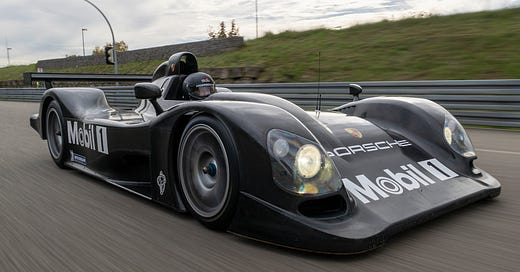



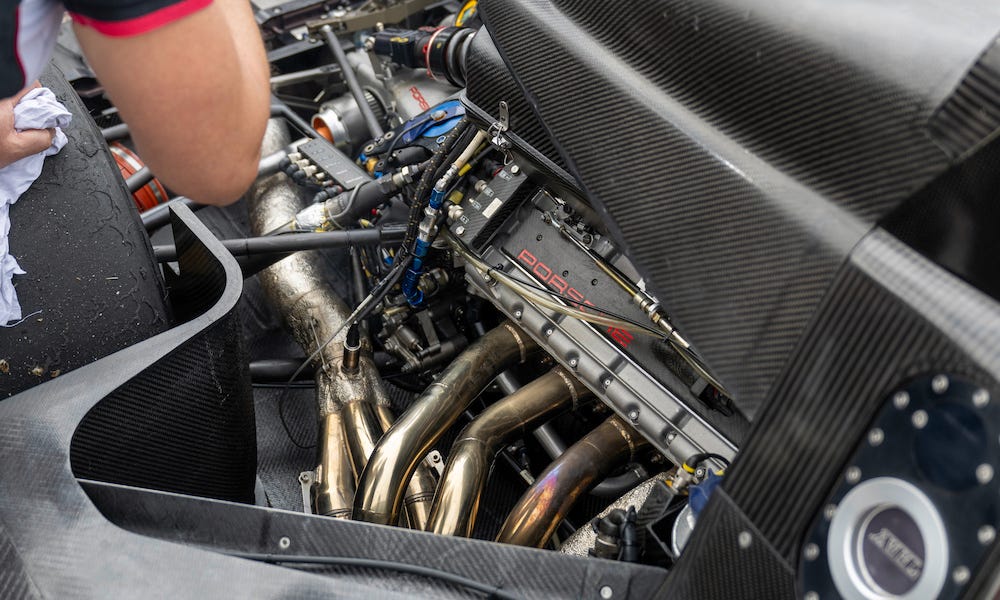
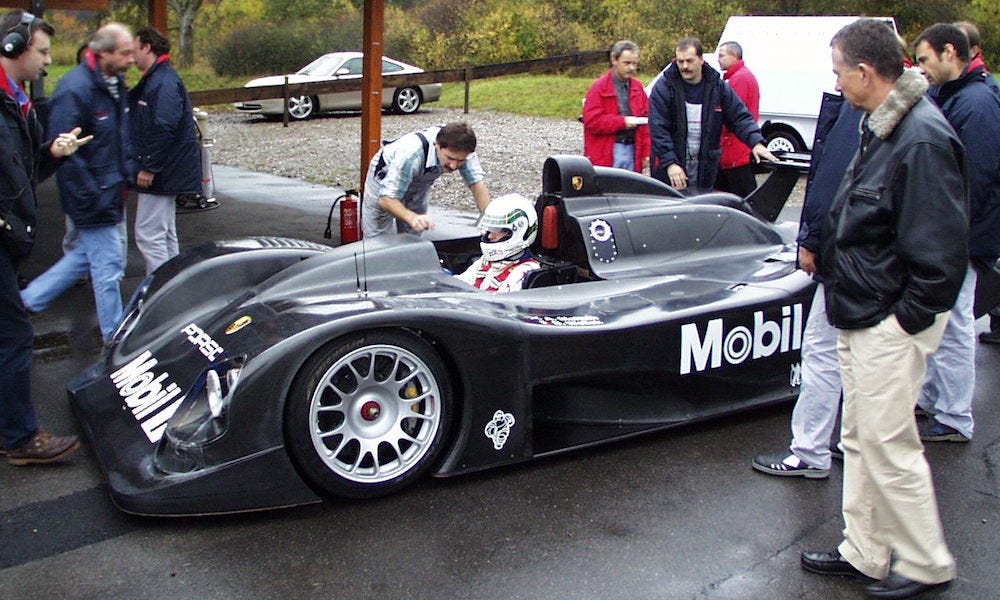
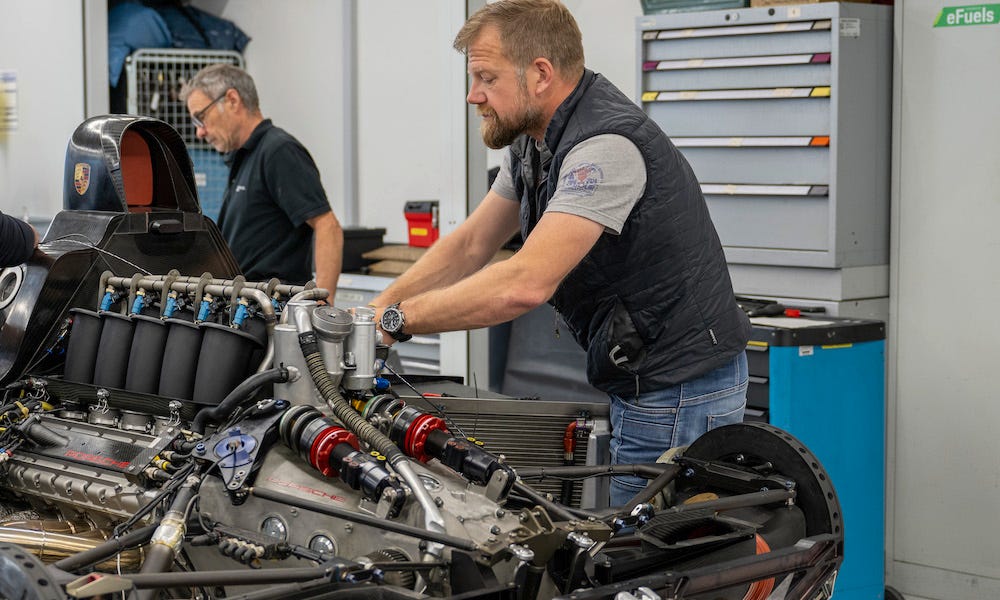
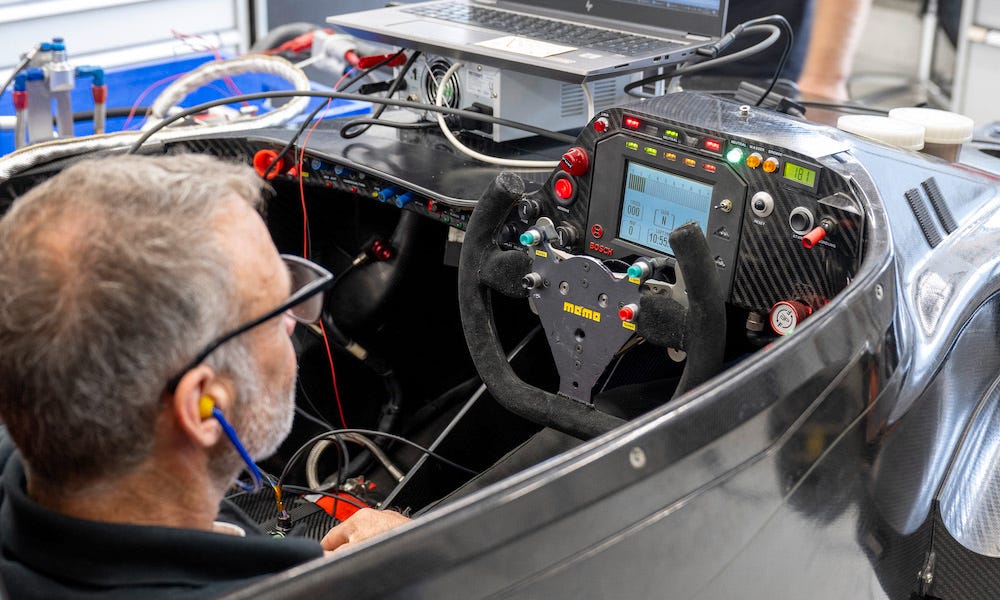

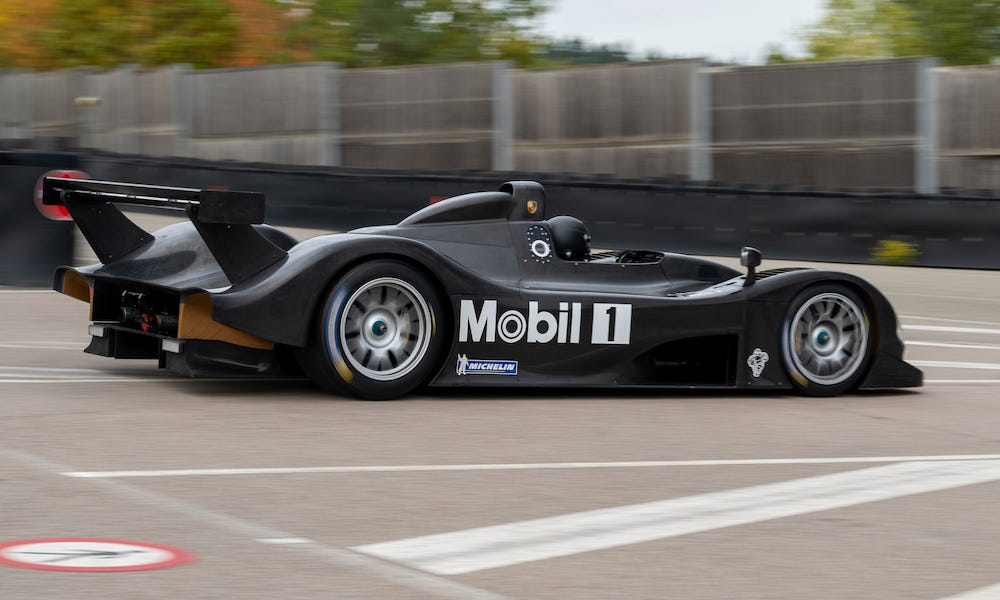
I'm sure this article brings up a lot of emotions for so many people involved in this project!
The cancellation of this project was a huge disappointment to a highly dedicated Porsche Motorsport team in Weissach at the time - all water under the bridge now!
Here are some insights to those two days.
Day 1, November 2nd 1999:
It had been raining, it was a cold winter day in Weissach (again!), air temp was 12C.
Bob Wollek was the first to drive the car, with Allan driving one lap at the end of the day, in preparation of the second day.
Only function testing was carried and the car was only pushed to a top speed of 216 km/h (134 mph).
Day 2, November 3rd 1999:
Another cold Weissach day, with only 9C (46F) highest air temp, but it was dry.
Allan Mc Nish was the only one to drive the car on the 2nd day and within the first few runs, he smashed the Weissach lap record, previously set with the Porsche 911 GT1.
The car achieved a top speed of 302 km/h (188 mph) and for those that know the short Weissach test track, that was incredibly fast - and this was certainly not a "full push" situation.
We were so excited about the performance and potential of the car, after just a rollout test.
It was a fantastically motivating feeling and we relished what was to come.
The article correctly states that the car only drove 78 km (48 mls) - and then was parked.
Just a side note, Norbert Singer's department car (the gold Porsche 911) in which he drove up to the test track with, can be seen in the background of the 3rd photo in the article.
Would love to see the Porsche LMP2000 car driving at Goodwood or anywhere, for that matter!
The single best Sportscar365 piece I've ever read.